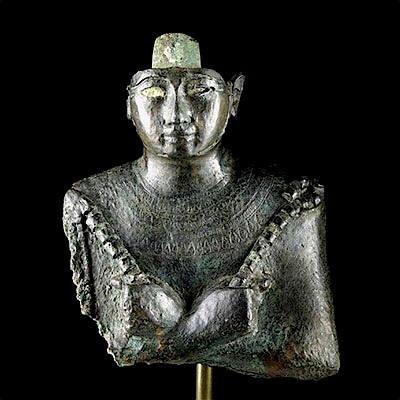Egyptian Gilded Polychrome Statue - Mourning Nephthys
Lot 1b
About Seller
Artemis Fine Arts
686 S Taylor Ave, Ste 106
Louisville, CO 80027
United States
Selling antiquities, ancient and ethnographic art online since 1993, Artemis Gallery specializes in Classical Antiquities (Egyptian, Greek, Roman, Near Eastern), Asian, Pre-Columbian, African / Tribal / Oceanographic art. Our extensive inventory includes pottery, stone, metal, wood, glass and textil...Read more
Estimate:
$30,000 - $40,000
Absentee vs Live bid
Two ways to bid:
- Leave a max absentee bid and the platform will bid on your behalf up to your maximum bid during the live auction.
- Bid live during the auction and your bids will be submitted real-time to the auctioneer.
Bid Increments
| Price | Bid Increment |
|---|---|
| $0 | $25 |
| $300 | $50 |
| $1,000 | $100 |
| $2,000 | $250 |
| $5,000 | $500 |
| $10,000 | $1,000 |
| $20,000 | $2,500 |
| $50,000 | $5,000 |
| $100,000 | $10,000 |
| $200,000 | $20,000 |
About Auction
By Artemis Fine Arts
May 22, 2019
Set Reminder
2019-05-22 10:00:00
2019-05-22 10:00:00
America/New_York
Bidsquare
Bidsquare : Exceptional Day 1: Antiquities Asian Fine Art
https://www.bidsquare.com/auctions/artemis-gallery/exceptional-day-1-antiquities-asian-fine-art-4129
Day 1 of an important 2-day auction featuring exceptional art from around the world - Egyptian, Greek, Etruscan, Roman, Viking, Russian, Near Eastern; Asian Art from China, Japan, Thailand, Vietnam, Burma, India; Fine Art from the 17th century to present. Artemis Fine Arts info@artemisgallery.com
Day 1 of an important 2-day auction featuring exceptional art from around the world - Egyptian, Greek, Etruscan, Roman, Viking, Russian, Near Eastern; Asian Art from China, Japan, Thailand, Vietnam, Burma, India; Fine Art from the 17th century to present. Artemis Fine Arts info@artemisgallery.com
- Lot Description
Egyptian, Late Dynastic to Ptolemaic Period, ca. 664 to 30 BCE. A stunning and finely-carved wooden statue depicting Nephthys, the goddess of death and darkness and one of the oldest deities in the Egyptian pantheon. She kneels while wearing a form-fitting gown, her arms secured to her torso with small nails, and holds her left hand neatly atop her thigh and raises her right hand - palm inward-facing - in front of her face in a gesture of mourning. Her pensive visage boasts downturned almond-shaped eyes, a slender nose above full lips, lightly-rounded cheeks, and cupped ears, all beneath the folds of a tripartite wig as well as a headdress in the shape of a temple or estate layout. Layers of chalky-white gesso across the figure create the ground upon which faded red, blue, blue-green, and flesh-toned pigment are presented, and her face still retains ample traces of fine gilding. Custom 1950s lacquered wood stand included. Size: 5.75" L x 4.25" W x 14.125" H (14.6 cm x 10.8 cm x 35.9 cm); 17" H (43.2 cm) on included custom stand.
The goddess Nephthys is one of the oldest deities of ancient Egypt and, accordingly, one of the most symbolically significant. She is the daughter of Geb (god of the earth) and Nut (goddess of the sky), and is the mother of Anubis, the jackal-headed god of embalming and the dead. Nephthys' association with death and darkness originates from the bipolarity of light and dark she shares with her sister Isis, the goddess of light and rebirth, and the symbols most-commonly associated with the goddess are the temple (as seen on her headdress), the hawk, and the sycamore tree.
Nephthys is so strongly linked with death that effigies of her likeness were regularly created and displayed during ancient Egyptian funerary ceremonies, and her portrait is one of four goddesses present in the tomb of Tutankhamen. In fact her namesake cult, the "Cult of Nephthys," is even credited for creating some of the first professional funerary mourners, nicknamed the "hawks of Nephthys." Funerary figures like this example were elaborately decorated to pay homage as well as to protect the body of the deceased. This figure was first covered in thick layers of gesso, then painted with brightly-colored pigments, and finally accentuated with thin layers of applied gilding. Funerary carvings of Nephthys were often accompanied by matching carvings of her sister, Isis, with each being placed near on atop the ends of a sarcophagus.
For a stylistically-similar example, please see The Brooklyn Museum, accession number 11.681: https://www.brooklynmuseum.org/opencollection/objects/3074
For another stylistically-similar example boasting a greater variety of colors, please see The Metropolitan Museum of Art, accession number 12.182.23a: https://www.metmuseum.org/art/collection/search/551501
Provenance: ex-private Joel Chen collection, Los Angeles, California, USA; ex-C. Morrill Gallery; ex-Stendahl Gallery, Los Angeles, California, USA, acquired around 1970
All items legal to buy/sell under U.S. Statute covering cultural patrimony Code 2600, CHAPTER 14, and are guaranteed to be as described or your money back.
A Certificate of Authenticity will accompany all winning bids.
We ship worldwide and handle all shipping in-house for your convenience.
#146238Arms reattached at shoulders and elbows with small nails, and headdress reattached to head with one nail and adhesive. Chipping and fading to gesso, original pigmentation, and gilding, with nicks and abrasions to legs, arms, body, and head, light insect damage, and encrustations. Nice earthen deposits, original pigmentation, and patina throughout. Great traces of gilding on face.Condition
- Shipping Info
-
All shipping is handled in-house for your convenience. Your invoice from Artemis Gallery will include shipping calculation instructions. If in doubt, please inquire BEFORE bidding for estimated shipping costs for individual items.
-
- Buyer's Premium



 EUR
EUR CAD
CAD AUD
AUD GBP
GBP MXN
MXN HKD
HKD CNY
CNY MYR
MYR SEK
SEK SGD
SGD CHF
CHF THB
THB















